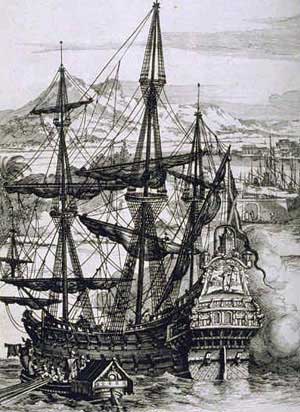
Galleons were large, multi-decked sailing ships developed in Spain and Portugal and first used as armed cargo carriers by Europeans from the 16th to 18th centuries during the Age of Sail and were the principal vessels drafted for use as warships until the Anglo-Dutch Wars of the mid-17th century. Galleons generally carried three or more masts with a lateen fore-and-aft rig on the rear masts, were carvel built with a prominent squared off raised stern, and used square-rigged sail plans on their fore-mast and main-masts.

Botafogo is a beachfront neighborhood (bairro) in Rio de Janeiro, Brazil. It is a mostly upper middle class and small commerce community, and is located between the hills of Mundo Novo, Dona Marta and São João. The word Botafogo also refers to a Latin American ballroom dance move that originated in this area.

The Battle of Diu was a naval battle fought on 3 February 1509 in the Arabian Sea, in the port of Diu, India, between the Portuguese Empire and a joint fleet of the Sultan of Gujarat, the Mamlûk Burji Sultanate of Egypt and the Zamorin of Calicut.

Cascais is a town and municipality in the Lisbon District of Portugal, located on the Portuguese Riviera. The municipality has a total of 214,158 inhabitants in an area of 97.40 km2. Cascais is an important tourist destination. Its marina hosts events such as the America's Cup and the town of Estoril, part of the Cascais municipality, hosts conferences such as the Horasis Global Meeting.

São Domingos de Rana is a civil parish of the Portuguese municipality of Cascais, part of the Greater Lisbon subregion. The population in 2011 was 57,502, in an area of 20.36 km2. The parish includes the localities Abóboda, Cabeço de Mouro, Caparide, Matarraque, Outeiro de Polima, Polima, Rana, Talaíde, Tires, Trajouce and Zambujal.

Infante Luís of Portugal, Duke of Beja was the second son of King Manuel I of Portugal and his second wife, Maria of Aragon. He participated in the Conquest of Tunis.

The naval Battle of Vila Franca do Campo, also known as Battle of Ponta Delgada and Naval Battle of Terceira Island, took place on 26 July 1582, off the coast of the island of São Miguel in the Portuguese archipelago of the Azores, during the War of the Portuguese Succession. A combined corsair expedition, mainly French, sailed against a Spanish naval force made up of Portuguese and Castilian ships, to preserve control of the Azores under the pretender António, Prior of Crato and to defend the islands from incorporation into the Iberian Union, the largest French force sent overseas before the age of Louis XIV.
Jorge Torlades O'Neill, was the titular and official head of the Clanaboy O'Neill dynasty, whose family has been in Portugal since the 18th century.

The conquest of Tunis occurred in 1535 when the Habsburg Emperor Charles V and his allies wrestled the city away from the control of the Ottoman Empire.

São Gabriel was a Portuguese carrack and the flagship of Vasco da Gama's armada on his first voyage to India in 1497–1499.

The Portuguese Indian Armadas were the fleets of ships funded by the Crown of Portugal, and dispatched on an annual basis from Portugal to India. The principal destination was Goa, and previously Cochin. These armadas undertook the Carreira da Índia from Portugal, following the maritime discovery of the Cape route, to the Indian subcontinent by Vasco da Gama in 1497–99.
The Roman villa of Outeiro de Polima is a Roman villa in the civil parish of São Domingos de Rana, in the Portuguese municipality of Cascais, dating from the 1st to 6th centuries AD.

The square-rigged caravel, was a sailing ship created by the Portuguese in the second half of the fifteenth century. A much larger version of the caravel, its use was most notorious beginning in the end of that century. The square-rigged caravel held a notable role in the Portuguese expansion during the Age of Discovery, especially in the first half of the sixteenth century, for its exceptional maneuverability and combat capabilities. This ship was also sometimes adopted by other European powers. Its hull resembled the shape of the later galleon and some scholars have claimed that this vessel is a forerunner of the fighting galleon, by the name of caravela de armada.
Pedro Soares de Sousa, also known as Pero Soares de Sousa exercised the role of the third Donatary-Captain for the island of Santa Maria, between 1571 and 1573, as well as between 1576 and 1580 and succeeded by Jerónimo Coutinho. He should not be confused with his descendant and seventh Donatary-Captain of Santa Maria, who in a testament dated 12 February 1634, referred to his 1616 ascendancy to the stewardship of Santa Maria.
Aurora Augusta Figueiredo de Carvalho Homem, known by her pen name Maria Aurora, was a Portuguese journalist, poet, novelist, children's writer and television presenter.
Maria João Espírito Santo Bustorff SilvaGOM is a Portuguese restoration specialist, philanthropist and former politician. She is known for her historical and cultural restoration and preservation work in both Portugal and Brazil through the Ricardo Espírito Santo Foundation, and also for being Minister of Culture during the government of Prime Minister Pedro Santana Lopes.

The Castle of Mirandela is a medieval castle in the civil parish of Mirandela, municipality of the same name, in the Portuguese district of Bragança.

Summer architecture was a Portuguese architectural movement originating in the Portuguese Riviera, in the late 19th and early 20th centuries, when the region became a popular resort destination for the Portuguese royal family and the Portuguese aristocracy. The movement is not characterized by any single architectural style or artistic school, but rather unified by common themes, including leisure, wellness, exoticism, and heterotopia.
The 2022 Campeonato Brasileiro Série C was a football competition held in Brazil, equivalent to the third division. It began on 9 April and ended on 8 October 2022.















